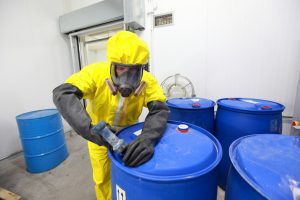The EPA announced food producer Hiland Dairy Foods Company LLC of Norfolk, Nebraska, has agreed to pay a $93,107 civil penalty to resolve alleged violations of the federal Clean Air Act’s (CAA) chemical accident prevention provisions.
According to the EPA, the company stores more than 10,000 pounds of anhydrous ammonia, a regulated toxic substance, and failed to comply with regulations intended to protect the surrounding community from accidental releases. The alleged violations included:
- Failure to conduct compliance audits at least every three years,
- Failure to update emergency contacts, and
- Failure to conduct and document emergency response coordination activities.
Anhydrous ammonia poses health risks because it’s corrosive to the skin, eyes, and lungs. At high levels of exposure, it can cause choking and fatalities.
“It is critical that companies that handle dangerous chemicals comply with the safety requirements of the [CAA],” said EPA Region 7 Enforcement and Compliance Assurance Division Director David Cozad in an Agency news release. “EPA is committed to protecting communities from potentially catastrophic releases, particularly those communities disproportionately affected by environmental harm.”
The community surrounding Hiland’s facility has been designated a potentially sensitive area by the EPA due to its proximity to a Superfund site and exposures to toxic air releases. Areas considered to be overburdened are priority enforcement areas for the Agency.
What is the chemical accident prevention program?
Under the CAA’s chemical accident prevention program, also known as the Risk Management Program, facilities using regulated toxic and/or flammable substances in a process in quantities above the established thresholds are required to develop risk management plans (RMPs), “which [identify] the potential effects of a chemical accident; [identify] steps a facility is taking to prevent an accident; and [spell] out emergency response procedures should an accident occur,” the Agency news release adds. “These plans provide valuable information to local fire, police and emergency response personnel to prepare for and respond to chemical emergencies in their community.”
The rule requires RMPs to address three areas:
- A hazard assessment that details the potential effects of an accidental release, an accident history of the last five years, and an evaluation of worst-case and alternative accidental releases;
- A prevention program that includes safety precautions and maintenance, monitoring, compliance audits, and employee training measures; and
- An emergency response program that spells out emergency healthcare, employee training measures, and procedures for informing the public and response agencies (such as the fire department) should an accident occur.
Facilities are required to revise and resubmit RMPs every five years.
Program levels
An underlying principle of the Section 112(r) program is that “one size does not fit all.” Under this principle, the EPA has classified processes into three programs to ensure individual processes are subject to requirements that appropriately match their size and the risks they pose:
- Program Level 1 applies to processes that wouldn’t affect the public in the situation of a worst-case release (in the language of Part 68, processes “with no public receptors within the distance to an endpoint from a worst-case release”) and with no accidents with specific off-site consequences within the past five years. Program 1 imposes limited hazard assessment requirements and minimal accident prevention and emergency response requirements.
- Program Level 2 applies to processes not eligible for Program 1 or subject to Program 3. Program 2 imposes streamlined accident prevention program requirements, as well as additional hazard assessment, management, and emergency response requirements.
- Program Level 3 applies to processes not eligible for Program 1 and either subject to the Occupational Safety and Health Administration’s (OSHA) Process Safety Management (PSM) standard under federal or state OSHA programs or classified in one of ten specified North American Industrial Classification System (NAICS) codes. Program 3 imposes a stringent accident prevention program, as well as additional hazard assessment, management, and emergency response requirements.
General Duty Clause
These toxic and/or flammable substances regulated by the Risk Management Program are also subject to the requirements of the General Duty Clause (GDC). The GDC makes the owners and operators of facilities that have regulated and other extremely hazardous substances in quantities below the Risk Management Program thresholds responsible for ensuring their chemicals are managed safely.
Among other things, facilities subject to the GDC are responsible for:
- Knowing the hazards posed by the chemicals and assessing the impacts of possible releases,
- Designing and maintaining a safe facility to prevent accidental releases, and
- Minimizing the consequences of accidental releases that do occur.
The “EPA has found that many regulated facilities are not adequately managing the risks that they pose or ensuring the safety of their facilities in a way that is sufficient to protect surrounding communities,” according to the Agency news release. “Approximately 150 catastrophic accidents occur per year among regulated facilities. These accidents result in fatalities, injuries, significant property damage, evacuations, sheltering in place or environmental damage. Many more accidents with lesser effects also occur, demonstrating a clear risk posed by these facilities.
“Reducing risks from accidental releases of hazardous substances at industrial and chemical facilities is a top priority for EPA, which identified this goal as one of its National Enforcement and Compliance Initiatives in 2024.”

